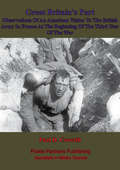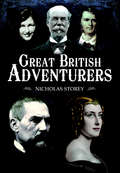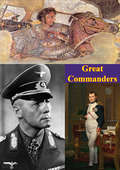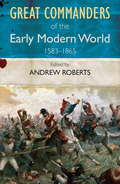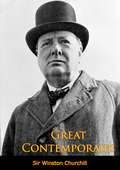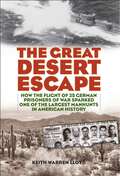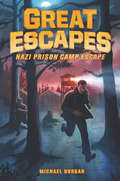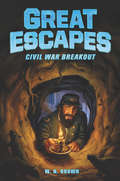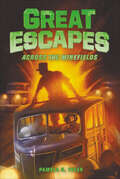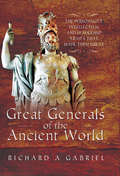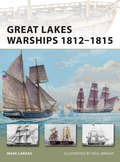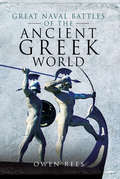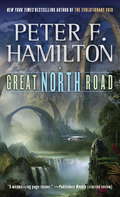- Table View
- List View
Great Britain’s Part —: Observations Of An American Visitor To The British Army In France At The Beginning Of The Third Year Of The War
by Paul D. CravathPaul Cravath was a prominent New York lawyer and partner of the law firm known as Cravath, Swaine and Moore: a leader of the Anglophile "Atlantacist" movement that preached closer ties with Britain in opposition to the isolationist policies of several American administrations. As part of his cause, he visited Britain during the First World War and wrote of his experiences and opinions on the war effort.An interesting political book, passionately argued.Author -- Cravath, Paul D. 1861-1940.Text taken, whole and complete, from the edition published in New York [etc.] D. Appleton and company, 1917.Original Page Count - vi and 127 pages
Great British Adventurers
by Nicholas StoreyIn selecting my adventurers, I have had to find limits. The first has been to confine my selection to men and women who are (at least loosely) British and, even then, service and adoption have sometimes, as with Krystyna Skarbeka, taken the place of birth, and I have chosen to ignore such things as competing national claims for Tenzing Norgay. The second limit that I have set myself is generally to exclude heroic adventurers in battle, simply because there is (rightly), so much already written about them, but I have found place for certain (representative) secret agents of the Second World War, whose acts (in voluntary service, beyond the call of simple duty), surely took them out of the arena of straightforward battle and into the realm of the most individual and courageous adventure. The result of these decisions remains to be judged but the overall objective has been to renew interest in the lives of some of our real heroes and heroines, as representative of the many others that there are; in an age in which contemporary sporting and pop art heroes dominate the news and provide the only readily evident inspiration, and also an age in which addiction to the computer screen nearly robs the young of memories and dreams of high adventure; of which ripping yarns are born. The third limit is a limit of time: this speaks for itself; otherwise howwould Drake and Raleigh, Clive of India, General Woolf and Captain Cook not have found their places? There have to be such limits. The final limit has been to exclude those who are widely famed already: what more is there to say of General Gordon or Dr David Livingstone of Captain Robert Falcon Scott and Captain Laurence Oates; even though what has been said should often be repeated? Moreover, although Sir Edmund Hillary is acknowledged as the first conqueror of Mount Everest; Tenzing Norgay was there with him and what of George Mallory who, some time before had died, either going up or coming down?To those who might accuse me of having been obscure, I just plead that my purpose has been to bring back into ready remembrance certain men and women, not widely fted now, who had great impact upon the accrual of knowledge of: other peoples, their customs and their countries; or who have striven, often against various obstacles (including the odds), to promote exploration and, sometimes, even to preserve life and liberty for others. To the erudite, who might say that I shed little new light and that the coverage is uneven, I plead, in mitigation of sentence, that my principal purpose has been to remind of worthy lives that might still stir our blood; and to bring them together, as representative of our adventurous people, in one handy volume.James Brooke, Rajah of Sarawak 1803–1868Mary Seacole 1805–1881 Richard and John Lander 1804–1834; 1806–1839Jane Digby 1807–1881General Sir James Abbott 1807–1896Colonel John Peard 1811–1880John William Colenso, 1st Anglican Bishop of Natal 1814–1883Sir Richard Burton 1821–1890 and John Hanning Speke 1827–1854 Emily Hobhouse 1860–1926Mary Kingsley 1862–1900Sir Francis Younghusband 1863–1942Colonel Percy Fawcett 1867–1925 and, in his wake, Peter Fleming OBE 1907–1971Cecil Henry Meares 1877–1937George Mallory 1886–1924 and Andrew Irvine 1902–1924Dame Freya Stark 1893–1993Sir Francis Chichester 1901–1972Gladys May Aylward 1902–1970Amy Johnson 1902–1941Krystyna Skarbek-Granville GM, OBE, Croix de Guerre Avec Palmes, born ca. 1908–1952Sir Fitzroy Hew Royle Maclean 1911–1996Tenzing Norgay GM 1914–1986 Violette Szabo GC, MBE 1921–1945The Present and the Future[Colonel John Blashford-Snell b. 1936Sir Ranulf Fiennes b. 1944Alan Hinkes b. 1954Adrian Hayes (45)Kenton Cool b. 1973Dame Ellen MacArthur b. 1976Rebecca Stephens b. 1982Xanadu and William Dalrymple]
Great Captains: of the Campaigns of Alexander, Hannibal, Cæsar, Gustavus Adolphus, Frederick, and Napoleon
by Brevet Lt.-Col. Theodore Ayrault DodgeThis book comprises six lectures delivered under the auspices of the Lowell Institute by Brevet Lieutenant-Colonel Theodore Ayrault Dodge in Boston in January, 1889.Each lecture focuses on a historically significant leader--namely Alexander, Hannibal, Cæsar, Gustavus Adolphus, Frederick, and Napoleon--and "aims to indicate briefly what we owe to the great captains, and to draw an intelligible outline of their careers."Dodge has utilized an abundance of sources of information, from Arrian's Anabasis of Alexander to Jomini's Life of Napoleon, and the book is illustrated with 21 maps.
Great Circle: A novel
by Maggie ShipsteadAn unforgettable story of a daredevil female aviator determined to chart her own course in life, at any cost—Great Circle spans Prohibition-era Montana, the Pacific Northwest, Alaska, New Zealand, wartime London, and modern-day Los Angeles. <P><P>After being rescued as infants from a sinking ocean liner in 1914, Marian and Jamie Graves are raised by their dissolute uncle in Missoula, Montana. There--after encountering a pair of barnstorming pilots passing through town in beat-up biplanes--Marian commences her lifelong love affair with flight. <P><P>At fourteen she drops out of school and finds an unexpected and dangerous patron in a wealthy bootlegger who provides a plane and subsidizes her lessons, an arrangement that will haunt her for the rest of her life, even as it allows her to fulfill her destiny: circumnavigating the globe by flying over the North and South Poles. <P><P>A century later, Hadley Baxter is cast to play Marian in a film that centers on Marian's disappearance in Antarctica. Vibrant, canny, disgusted with the claustrophobia of Hollywood, Hadley is eager to redefine herself after a romantic film franchise has imprisoned her in the grip of cult celebrity. <P><P>Her immersion into the character of Marian unfolds, thrillingly, alongside Marian's own story, as the two women's fates--and their hunger for self-determination in vastly different geographies and times--collide. Epic and emotional, meticulously researched and gloriously told, Great Circle is a monumental work of art, and a tremendous leap forward for the prodigiously gifted Maggie Shipstead. <P><P><b>A New York Times Bestseller</b>
Great Commanders [Illustrated Edition]
by Dr Christopher GabelIncludes 3 maps and 7 illustrationsThe command of military forces in combat is unlike any other field of human endeavor. If war is the ultimate form of human competition, then the commander is the ultimate competitor. The commander operates in an environment of chance, uncertainty, and chaos, in which the stakes are, quite literally, life and death. He or she contends against an adversary who is using every means, fair or foul, to foil his plans and bring about his defeat. The commander is ultimately responsible for every variable that factors into military success or failure-training, logistics, morale, equipment, planning, and execution. The commander reaps the lion's share of plaudits in victory, but also must accept the blame in defeat, warranted or not. Very often the line that separates fame and ignominy is slender indeed.It is not difficult to identify "great" commanders, though the overwhelming majority of generals who win battles are never considered "great." Something more than a favorable ratio of wins to losses is needed to establish greatness...The truly great commander is generally considered to be one who attains the unexpected or the unprecedented; one who stands above his contemporaries through his skill on the battlefield, or through the sheer magnitude of his accomplishments....The commanders selected were masters of warfare in their particular time and environment. Each capitalized upon the social, political, economic, and technological conditions of his day to forge successful military forces and win significant and noteworthy victories that profoundly altered the world in which he lived.-Dr Christopher R. Gabel.The Great Commanders covered by this volume are Alexander the Great, Genghis Khan, Napoleon, John J. Pershing, Erwin Rommel and Curtis E. LeMay
Great Commanders of the Early Modern World: 1567-1865
by Andrew RobertsWhat qualities made the Duke of Wellington a strategic genius? How did Oliver Cromwell, a gentleman farmer, create an army that overthrew a king and changed the course of British history? Why was Simón Bolívar able to overcome early defeats to become the greatest figure in the Latin American struggle against Spanish colonialism. In Great Commanders of the Early Modern World, Andrew Roberts has assembled some of our most distinguished historians (including such names as Antonia Fraser, Saul David and Philip Dwyer) to provide an authoritative account of the lives and careers of the 26 greatest military commanders of the period, from the Duke of Marlborough to Napoleon Bonaparte, Robert Clive to Carl von Clausewitz, and Frederick the Great to Shaka Zulu. As accessible and informative as it is rigorous and scholarly, Great Commanders of the Early Modern World is the perfect introduction to its subject for the general reader, but also a stimulating and thought-provoking read for those with greater knowledge of military history. Along with the other volumes in the Great Commanders series, it is an indispensable guide to the greatest generals the world has seen.
Great Contemporaries [Revised Edition]
by Sir Winston ChurchillThis is a collection of 25 short biographical essays about famous people, written and published by Winston Churchill before his first tenure as Britain’s Prime Minister from 1940-1945.The original collection of 21 essays was published in 1937, mainly written between 1928 and 1931. This 1939 edition contains four additional essays on Lord Fisher, Charles Stewart Parnell, Lord Baden-Powell and Franklin D. Roosevelt.“THESE essays on Great Men of our age have been written by me at intervals during the last eight years. Although each is self-contained, they throw from various angles, a light upon the main course of the events through which we have lived. I hope they will be found to illustrate some of its less well-known aspects. Taken together they should present not only the actors but the scene. In their sequence they may perhaps be the stepping-stones of historical narrative.The central theme is of course the group of British statesmen who shone at the end of the last century and the beginning of this—Balfour, Chamberlain, Rosebery, Morley, Asquith and Curzon. All lived, worked and disputed for so many years together, knew each other well, and esteemed each other highly. It was my privilege as a far younger man to be admitted to their society and their kindness. Reading again these chapters has brought them back to me, and made me feel how much has changed in our political life. Perhaps this is but the illusion which comes upon us all as we grow older. Certainly we must all hope this may prove to be so. In the meantime those to whom these great men are but names—that is to say the vast majority of my readers—may perhaps be glad to gain from these notes some acquaintance with them.”“By far the most important, thoughtful edition of Churchill’s famous personality sketches ever published...The indispensable ‘desert island’ text for any marooned Churchillian.”—Finest Hour“Interesting, well written and worth reading.”—Kirkus Reviews
Great Court-Martial Cases
by Joseph DimonaGreat Court-Martial Cases is a history of the military trials that shook the nation, from Benedict Arnold to Lieutenant Calley, taken from recently released official trial records.
Great Desert Escape: How the Flight of 25 German Prisoners of War Sparked One of the Largest Manhunts in American History
by Keith Warren LloydDramatic, highly readable, and painstakingly researched, The Great Desert Escape brings to light a little-known escape by 25 determined German sailors from an American prisoner-of-war camp. The disciplined Germans tunneled unnoticed through rock-hard, sunbaked soil and crossed the unforgiving Arizona desert. They were heading for Mexico, where there were sympathizers who could help them return to the Fatherland. It was the only large-scale domestic escape by foreign prisoners in US history. Wrung from contemporary newspaper articles, interviews, and first-person accounts from escapees and the law enforcement officers who pursued them, The Great Desert Escape brings history to life. At the US Army&’s prisoner-of-war camp at Papago Park just outside of Phoenix, life was, at the best of times, uneasy for the German Kreigsmariners. On the outside of their prison fences were Americans who wanted nothing more than to see them die slow deaths for their perceived roles in killing fathers and brothers in Europe. Many of these German prisoners had heard rumors of execution for those who escaped. On the inside were rabid Nazis determined to get home and continue the fight. At Papago Park in March 1944, a newly arrived prisoner who was believed to have divulged classified information to the Americans was murdered—hung in one of the barracks by seven of his fellow prisoners. The prisoners of war dug a tunnel 6 feet deep and 178 feet long, finishing in December 1944. Once free of the camp, the 25 Germans scattered. The cold and rainy weather caused several of the escapees to turn themselves in. One attempted to hitchhike his way into Phoenix, his accent betraying him. Others lived like coyotes among the rocks and caves overlooking Papago Park. All the while, the escapees were pursued by soldiers, federal agents, police and Native American trackers determined to stop them from reaching Mexico and freedom.
Great Educators of Three Centuries: Their Work and its Influence on Modern Education
by Frank Pierrepont GravesThis book offers great insight of the thoughts of renowned educators of past centuries, and it powerfully mediates such insight to today's educational practitioners.Frank Pierrepont Graves, American educator, lawyer Decorated Knight of Crown of Belgium, 1925; Officer Legion of Honor, French, 1937. Awarded Butler medal for educational administration, 1927; medal of Academy of Public Education, 1936; gold medal of Holland Society, 1937; American Ednl. Award (Associate Exhibitors), 1941.“I have felt that an account of the life and work of the men who, during the past three centuries, have introduced various innovations and reforms into modern education might contain interest and value for many who would never read a more comprehensive and unified production. I have, however, made some attempt as well to present the social setting of each reformer. Moreover, although the facts of biography are narrated somewhat at length, an effort has been made to eliminate everything that does not seem to have some bearing upon the contributions of the educator under consideration or upon the spread and permanence of his work. Such a treatment, I venture to hope, will prove of service to the general reader and to the student of educational origins whose time is limited. The volume may be used as a reference work, a reading circle book, or even as a text for classes that are not in condition to cope with the complexities of modern educational history. The worth of the book for any of these purposes has probably been heightened by a liberal quotation from the sources in the body of the text and the addition of supplementary readings at the end of each chapter.”
Great Escape Forger: The Work of Carl Holmstrom—POW#221. An Artist in Stalag Luft III
by Susan Holmstrom KohnowichCarl Holmstrom’s superb artwork depicts life as a ‘kriegie’ in a unique manner. But, more than that, he spent the major part of his captivity in Stalag Luft III Prisoner of War Camp, famous for ‘The Great Escape’. The audacity of the 76 escapees was only matched by the callousness of the Nazis who murdered 50 after recapture. As well as skillfully recording camp life, Carl forged invaluable official documents. He also sketched his fellow prisoners and encouraged others to take up drawing as hobby. Remarkably he saved over 200 examples of his work by carrying them on the appallingly arduous 1945 winter march from Poland into Germany. Post war, Carl Holmstrom said, “The drawings were made during imprisonment and represent a sincere effort to portray to the American people and especially to the relatives of the prisoners, intimate glimpses of Kriegie life.” His words proved to be prophetic. An expansion of his earlier self-published Kriegie Life, this superb book honors Carl’s exceptional artistic gift. This book has strong claim to contain the finest collection of POW art to emerge from Nazi-occupied Europe.
Great Escapes #1: Nazi Prison Camp Escape (Great Escapes #1)
by Michael BurganAre you ready for some of the most exciting, death-defying escape stories ever told? Perfect for fans of the I Survived series, the first installment in a brand-new, edge-of-your-seat series based on real events! In spring 1942, Royal Air Force pilot Bill Ash’s plane was shot down by Germans, who captured and eventually brought him to Stalag Luft III, a notorious camp for prisoners of war. The Germans boasted that the camp—which was isolated, heavily guarded, and surrounded by wire fences—was escape proof. But Ash was ready to prove them wrong. He, along with other POWs, would dig tunnels, hide in shower drains, or jump on trucks—all in the name of freedom. Because resisting the Germans was their mission, and escaping was their duty.From reluctant reader to total bookworm, each book in this page-turning series—featuring fascinating bonus content and captivating illustrations—will leave you excited for the next adventure!
Great Escapes #3: Civil War Breakout (Great Escapes #3)
by W. N. BrownAre you ready for some of the most exciting, death-defying escape stories ever told? The third installment in the unputdownable Great Escapes series is here—perfect for fans of the I Survived series!Civil War, 1863. Virginia. Union soldiers Colonel Thomas Rose and Major A. G. Hamilton were captured by the Confederate Army and taken to Libby Prison—one of the most horrific prisons ever run.Few ever made it out of the overcrowded, vermin-infested prison alive.But neither fear, nor darkness, nor squealing rats could keep Rose and Hamilton from freedom. They and other POWs would fight against the odds to attempt the largest prison escape in American history. From reluctant reader to total bookworm, each book in this page-turning series—featuring fascinating bonus content and captivating illustrations—will leave you excited for the next adventure!
Great Escapes #6: Across the Minefields (Great Escapes Ser. #6)
by Pamela D. Toler W. N. BrownAre you ready for some of the most exciting, death-defying escape stories ever told? The sixth installment in the Great Escapes series is here—perfect for fans of the I Survived series!June, 1942—Libya. Free French Officer Susan Travers was one of the few women on the frontlines in Africa during World War Two. After the Germans surrounded the military camp of Bir Hakeim, a shocking order was issued. The French troops were going to break out in the middle of the night—crossing through dangerous minefields and enemy territory—to reach their British allies. And Officer Travers would be leading the charge.With the lives of thousands of military men at risk, stakes were high. But Officer Travers didn’t face rejection and break gender barriers to back down now. Her country needed her to fight. And win. For reluctant readers to total bookworms, this gripping historical fiction story—featuring fascinating bonus content and captivating illustrations—will leave you eager to read the whole series!
Great Escapes of World War II
by George SullivanThe true stories of 7 dating escapes by prisoners of war during WWII including Colditz Castle, Auschwitz, Stalag Luft III, and more.
Great Generals of the Ancient World: The Personality, Intellectual and Leadership Traits That Made Them Great
by Richard A. GabrielThe military expert and author of Philip II of Macedonia presents 9 profiles of exemplary leadership from the ancient world. Of all the military commanders throughout history, only a few are remembered as great leaders of men in battle. Is there a combination of personal attributes and historical circumstances that produces great commanders? Professor Richard A. Gabriel analyses the biographies of ten great generals, all of whom lived between 1481 BC and AD 632, in order to identify the characteristics of intellect, psychology, personality, and experience that allowed them to tread the path to greatness. Some of the names included in Gabriel&’s selection, such as Moses and Muhammad, will surprise many readers—as will the historical figures Gabriel chooses to omit, including Alexander the Great and Atilla the Hun. But Gabriel is not merely interested in famous military exploits. A retired soldier and professor at the Canadian Defence College, he distils the timeless essence of military leadership through the examples of Julius Caesar, Philip II of Macedonia, Thutmose III of Egypt, and others
Great Hunting Rifles: Victorian to the Present
by Terry WielandIn Great Hunting Rifles, firearms expert Terry Wieland leads the reader on a journey through the history of some of the most exquisite rifles made in the twentieth century.The rifles featured in the book, all personally owned by the author and described in loving detail, were chosen for their particular importance. Each rifle either represents a particular era of gun making, is historically important, or is simply a paragon of gun making skill. In his treatment of these special rifles, Wieland provides a close look at some individual guns that are superb in a unique way, and which illustrate high points of the twentieth century. Each chapter is dedicated to one particular rifle, and is accompanied by photographs of the author's own examples, including:James Woodward hammer double .450 Express 3 1/4" Holland & Holland hammer .500 Express 3 1/4" Haenel-Mannlicher bolt action .450 Ackley custom rifle Mannlicher-Schoenauer Model 1908 Savage Model 1899 Al Biesen custom .270 Winchester .505 Gibbs custom built on a Granite Mountain Mauser 98 And many more! Great Hunting Rifles is perfect for anyone who wants to know more about the history of those few, special rifles that have made their mark on time.
Great Lakes Naval Training Station (Images of America)
by Therese GonzalezGreat Lakes Naval Training Station was authorized as a "training ship on land" in 1904. The base opened on July 1, 1911, and the first class of 300 U.S. sailors graduated four months later in a grand ceremony attended by Pres. William H. Taft as guest of honor. It has since sent to the fleet over four million sailors, serving the nation through all the conflicts of the 20th century. Today Great Lakes is the sole remaining navy boot camp in the United States. Anchored by the stately Building One, the entire 43-building complex was designated as Great Lakes Naval Training Station on the National Register of Historic Places in 1986. This book, with over 200 vintage images, explores its colorful and important history.
Great Lakes Warships 1812-1815
by Paul Wright Mark LardasWhen war broke out in 1812, neither the United States Navy nor the Royal Navy had more than a token force on the Great Lakes. However, once the shooting started, it sparked a ship-building arms race that continued throughout the war. This book examines the design and development of the warships built upon the lakes during the war, emphasizing their differences from their salt-water contemporaries. It then goes onto cover their operational use as they were pitted against each other in a number of clashes on the lakes that often saws ships captured, re-crewed, and thrown back against their pervious owners. Released in 2012 to coincide with the 200th anniversary of the outbreak of the war, this is a timely look at a small, freshwater naval war.
Great Maritime Patrol Aircraft of the World: From the Curtiss “America” to the Kawasaki P-1
by Ralph J. DeanAn action-filled, highly readable history of the great maritime patrol aircraft of the world, spanning WWI to the present.
Great Military Disasters: From Bannockburn to Stalingrad
by Julian SpilsburyGreat Military Disasters tells the dramatic stories behind the world's most calamitous conflicts. From the French army's failure to understand the impact of new technology at Crécy to Hitler's blatant overconfidence at Stalingrad, military historian Julian Spilsbury provides thrilling accounts of each disaster, covering exactly what went wrong, how and why. Of course, a disastrous outcome for one side meant victory for another, so as well as exploring the reasons the conflict ended in disaster, Great Military Disasters also reveals the key to victory. Eyewitness quotations add another dimension to this intriguing study of human incompetence of the gravest kind.
Great Military Disasters: From Cannae To Stalingrad
by Julian SpilsburyGreat Military Disasters tells the dramatic stories behind the world's most calamitous conflicts. From the French army's failure to understand the impact of new technology at Crécy to Hitler's blatant overconfidence at Stalingrad, military historian Julian Spilsbury provides thrilling accounts of each disaster, covering exactly what went wrong, how and why. Of course, a disastrous outcome for one side meant victory for another, so as well as exploring the reasons the conflict ended in disaster, Great Military Disasters also reveals the key to victory. Eyewitness quotations add another dimension to this intriguing study of human incompetence of the gravest kind.
Great Naval Battles of the Ancient Greek World
by Owen ReesNaval warfare is the unsung hero of ancient Greek military history, often overshadowed by the more glorified land battles. Owen Rees looks to redress the balance, giving naval battles their due attention. This book presents a selection of thirteen naval battles that span a defining century in ancient Greek history, from the Ionian Revolt and Persian Invasion to the rise of external naval powers in the Mediterranean Sea, such as the Carthaginians.Each battle is set in context. The background, wider military campaigns, and the opposing forces are discussed, followed by a narrative and analysis of the fighting. Finally, the aftermath of the battles are dealt with, looking at the strategic implications of the outcome for both the victor and the defeated. The battle narratives are supported by maps and tactical diagrams, showing the deployment of the fleets and the wider geographical factors involved in battle. Written in an accessible tone, this book successfully shows that Greek naval warfare did not start and end at the battle of Salamis.
Great Naval Battles of the Pacific War: The Official Admiralty Accounts: Midway, Coral Sea, Java Sea, Guadalcanal & Leyte Gulf
by John GrehanThe key naval battles against Imperial Japan in the Pacific during the Second World War have been described many times by numerous diligent and skilful historians. Such histories are, of course, the products of many years, even decades, of accumulated knowledge, but also of a received consensus of how the war played out to its, seemingly, inevitable conclusion. That of course is not how it was perceived at the time. Hindsight, as we know, gives us 20/20 vision. The accounts here, compiled for and on behalf of the Admiralty, were written either during or immediately after the end of the war before historians had begun to give their assessments of these momentous events. These accounts were written for internal consumption, to guide and instruct naval officers. It was never intended that they would be released to the general public. As such, there was no jingoistic drum beating, no axes to grind, no new angles to try and find. The authors of these accounts relate each battle, move by move, as they unfolded, accurately and dispassionately. This makes these accounts so invaluable. They read almost like a running commentary, as action follows action, minute follows minute. This sensation is magnified by the absolute impartiality of the authors, their sole attempt being to provide a thorough but very clear and comprehensible record so that others in the future could understand precisely how each battle was fought. These accounts can never be superseded and never replaced. Written by naval officers of the time for naval officers of the future, they are the permanent record of the great victories, and the sobering defeat in the Java Sea, during the struggle for control of the Pacific which, for many months, hung precariously in the balance.
Great North Road
by Peter F. HamiltonNAMED ONE OF THE BEST BOOKS OF THE YEAR BY PUBLISHERS WEEKLY. New York Times bestselling author Peter F. Hamilton’s riveting new thriller combines the nail-biting suspense of a serial-killer investigation with clear-eyed scientific and social extrapolation to create a future that seems not merely plausible but inevitable. A century from now, thanks to a technology allowing instantaneous travel across light-years, humanity has solved its energy shortages, cleaned up the environment, and created far-flung colony worlds. The keys to this empire belong to the powerful North family—composed of successive generations of clones. Yet these clones are not identical. For one thing, genetic errors have crept in with each generation. For another, the original three clone “brothers” have gone their separate ways, and the branches of the family are now friendly rivals more than allies. Or maybe not so friendly. At least that’s what the murder of a North clone in the English city of Newcastle suggests to Detective Sidney Hurst. Sid is a solid investigator who’d like nothing better than to hand off this hot potato of a case. The way he figures it, whether he solves the crime or not, he’ll make enough enemies to ruin his career. Yet Sid’s case is about to take an unexpected turn: because the circumstances of the murder bear an uncanny resemblance to a killing that took place years ago on the planet St. Libra, where a North clone and his entire household were slaughtered in cold blood. The convicted slayer, Angela Tramelo, has always claimed her innocence. And now it seems she may have been right. Because only the St. Libra killer could have committed the Newcastle crime. Problem is, Angela also claims that the murderer was an alien monster. Now Sid must navigate through a Byzantine minefield of competing interests within the police department and the world’s political and economic elite . . . all the while hunting down a brutal killer poised to strike again. And on St. Libra, Angela, newly released from prison, joins a mission to hunt down the elusive alien, only to learn that the line between hunter and hunted is a thin one.
